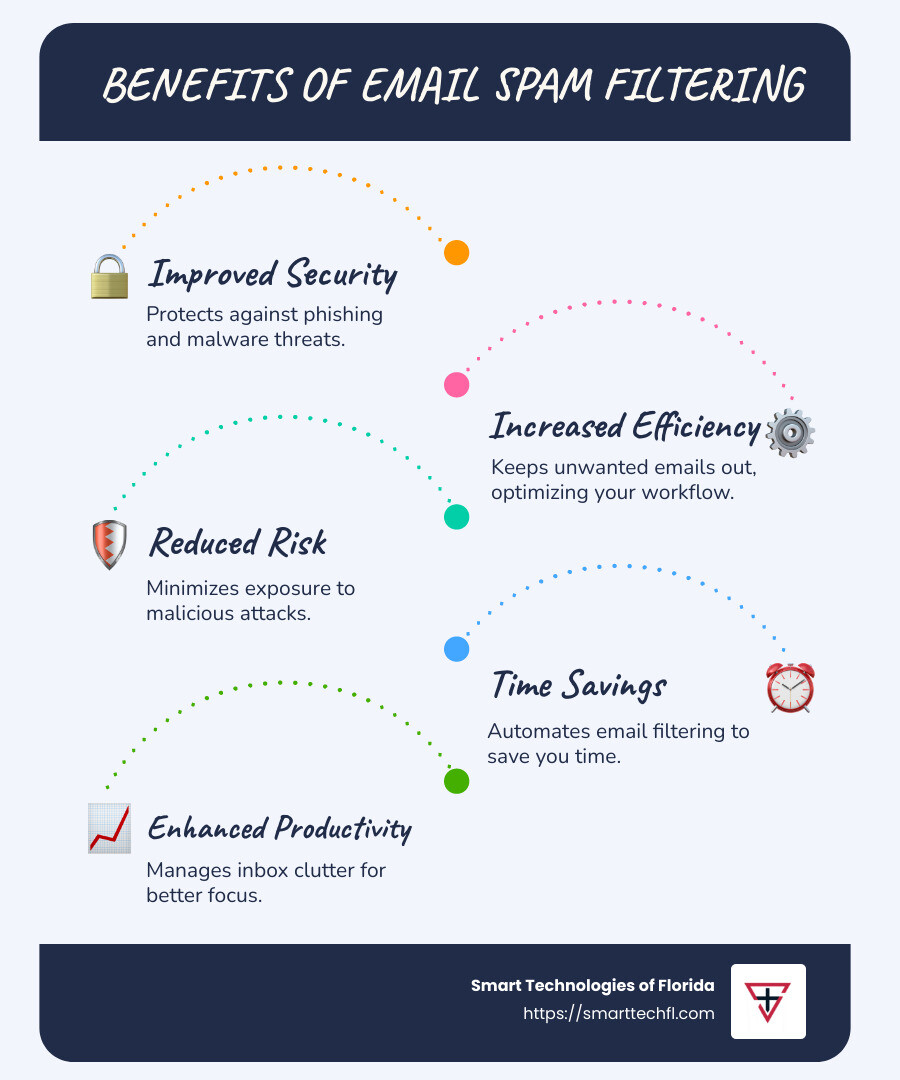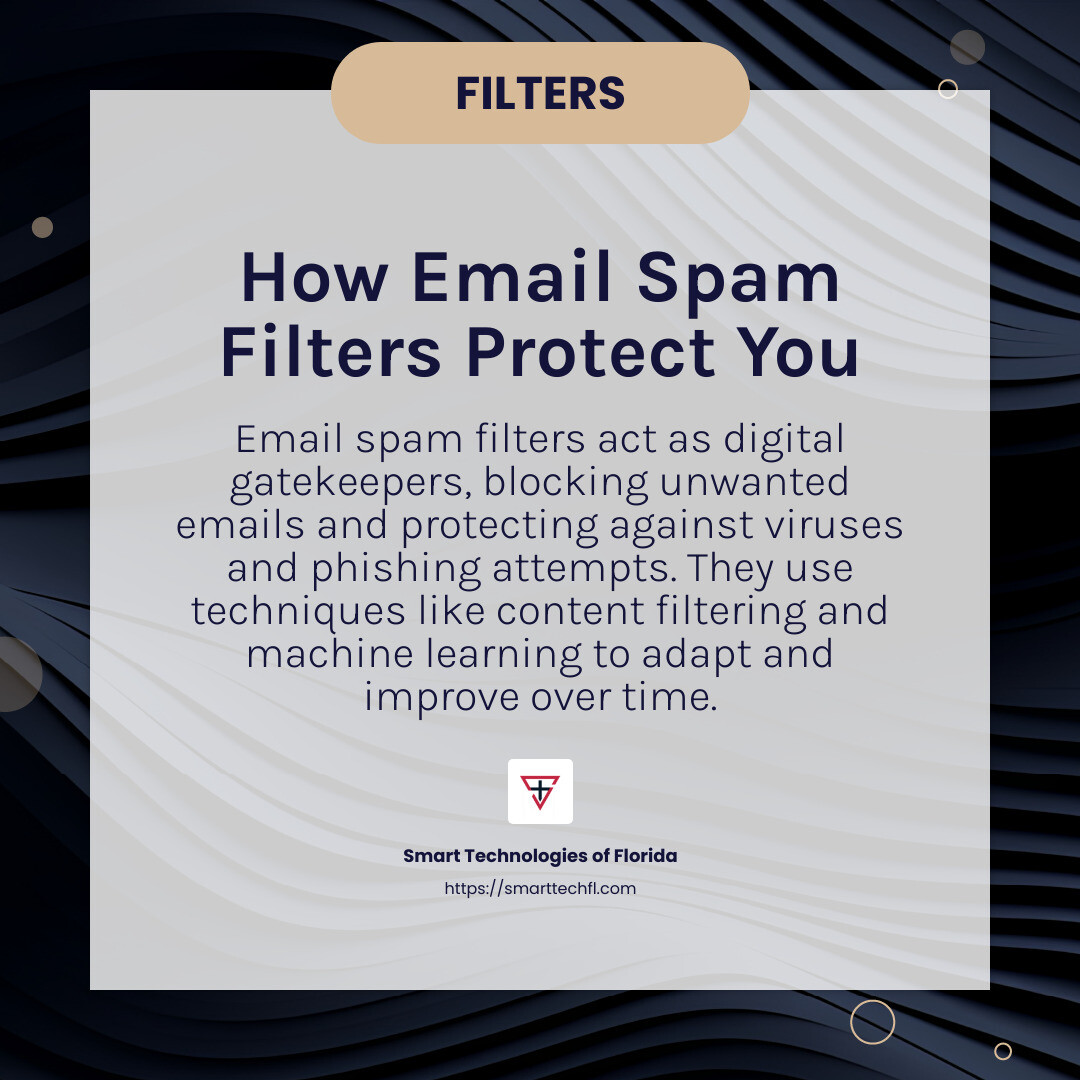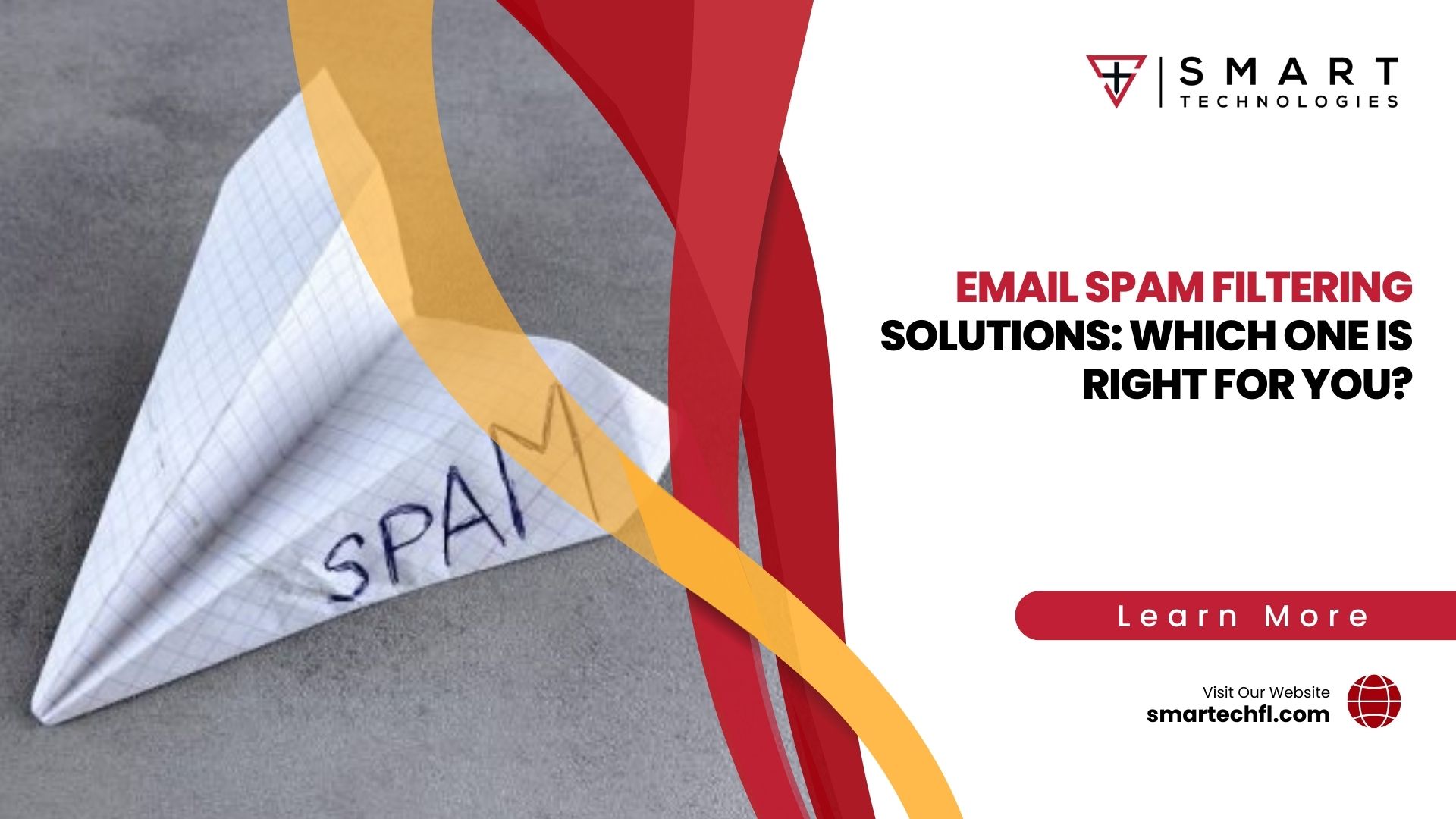Navigating the World of Email Spam Filters: A Beginner’s Guide
An email spam filter is your first line of defense against the relentless tide of unwanted messages flooding your inbox. These powerful tools sift through your emails, separating the useful from the useless, and provide vital protection from potential threats.
Here’s a quick takeaway:
- Purpose: Keeps unwanted emails out.
- Security: Protects against phishing, malware, and other threats.
- Productivity: Saves you time by managing your inbox clutter.
Emails are an essential part of communication, both for personal and business purposes. However, the inbox can quickly become clogged with spam, reducing productivity and increasing the risk of cyber threats. This is especially critical for business owners who rely on email for effective customer engagement and operations.
Email spam filtering is crucial because it not only optimizes efficiency but also boosts security by preventing malicious attacks. As a mid-sized retail business owner, protecting your business and increasing your productivity with an effective email spam filter is key to success.

Understanding Email Spam Filters
Email spam filters are like digital gatekeepers for your inbox. They help keep unwanted emails at bay and protect your device from harmful content. Let’s break down how they do this.
Spam Detection
Imagine your inbox as a party guest list. You only want invited guests (important emails) to get in. Spam detection acts like a bouncer, checking each email against a list of rules to see if it should be allowed in or shown the door.
Spam filters use various techniques to spot unwanted emails. Content filters look for specific words or phrases often found in spam, like “free money” or “click now.” Blacklist filters block emails from known spammers. More advanced filters use machine learning to adapt and recognize new spam patterns over time.
Dealing with Unwanted Emails
Unwanted emails can clutter your inbox and make it hard to find important messages. They also waste your time. By using an email spam filter, you can automatically sort out these nuisances and keep your inbox clean.
A good spam filter not only catches obvious spam but also learns from what you mark as unwanted. Over time, it gets better at knowing what you don’t want to see, making your email experience smoother and more efficient.
Virus Protection
Spam emails aren’t just annoying—they can be dangerous. Some contain links to malicious websites or attachments with viruses that can harm your computer. This is where the virus protection feature of spam filters comes in.
Spam filters scan emails for signs of harmful content. They check links and attachments for malware or phishing attempts, which are tricks to steal your personal information. By blocking these threats before they reach your inbox, spam filters help keep your digital world safe.

In short, email spam filters are essential tools that help manage your inbox by detecting spam, handling unwanted emails, and providing virus protection. These filters not only boost productivity by reducing clutter but also improve security by preventing potential cyber threats.
Types of Email Spam Filters
Email spam filters come in various types, each with its own way of keeping your inbox clean and safe. Let’s explore some of the most common types.
Content-Based Filters
Content-based filters analyze the text within an email to decide if it’s spam. They look for specific words or phrases that often appear in spam emails, like “discount” or “limited offer.” These filters are great at catching emails that try to play on your emotions, such as those promising quick riches or playing on fears.
Blocklist Filters
Blocklist filters work by checking the sender’s email address against a list of known spammers. If an email comes from an address on this list, it’s automatically blocked. These lists are updated regularly to keep up with spammers who change their addresses frequently.
Heuristic Filters
Heuristic filters use a set of rules to evaluate emails. They look at various aspects, such as the email’s structure and the frequency of certain words. This type of filter can adapt to new spam tactics by learning from previous emails, making it more effective over time.
Bayesian Filters
Bayesian filters use statistical techniques to determine if an email is spam. They compare the probability of certain words appearing in spam emails versus legitimate ones. Over time, these filters get better at distinguishing spam from genuine emails by learning from your actions—like what you mark as spam or not.
Challenge-Response Filters
Challenge-response filters take a different approach. When an email comes in, the sender is asked to verify themselves by completing a simple task, like typing a code. This method is effective at blocking automated spam bots but can sometimes be a hassle for legitimate senders.
Rule-Based Filters
Rule-based filters allow users to set specific criteria for handling emails. For example, you can create rules to automatically move emails containing certain keywords to a spam folder. This gives you more control over what gets filtered, making it easier to manage your inbox.
Each of these spam filter types has its strengths and weaknesses. By understanding how they work, you can choose the right combination to keep your inbox free from unwanted emails and potential threats.
In the next section, we’ll dig into how these filters work behind the scenes to scan emails in real-time, block malware, and protect against phishing.
How Email Spam Filters Work
Email spam filters are like digital bodyguards for your inbox. They work tirelessly to keep unwanted emails out while letting the important ones in. Let’s explore how they do this through real-time scanning, malware blocking, and phishing protection.
Real-Time Scanning
Real-time scanning is the heartbeat of any effective email spam filter. As soon as an email arrives, the filter analyzes it instantly. This quick action helps ensure that spam doesn’t even get a chance to reach your inbox.
The filter checks for signs of spam, like suspicious links or unusual attachments. By doing this in real-time, it stops threats before they can cause harm. Imagine if every email had to pass through a security checkpoint—real-time scanning is that checkpoint, working at lightning speed.
Malware Blocking
Malware can hide in emails, waiting to sneak into your computer. Email spam filters are equipped to block these harmful threats. They scan attachments and links for malware, ensuring they don’t carry viruses or other malicious software.
By blocking malware, these filters protect your device from being infected. This is crucial since malware can steal personal information or even take control of your computer. With a good filter in place, you can open your emails with peace of mind, knowing that potential threats are being stopped in their tracks.
Phishing Protection
Phishing emails are like digital traps, trying to trick you into giving away personal information. Email spam filters are trained to spot these sneaky attempts. They look for signs of phishing, such as fake email addresses or misleading links.
Phishing protection is essential because these emails often look legitimate, mimicking real companies or services. Filters help by identifying these scams and keeping them out of your inbox. This way, you’re less likely to fall for a phishing attack, protecting your sensitive information.
In summary, email spam filters work tirelessly to scan emails in real-time, block malware, and protect against phishing. They act as a robust defense system, ensuring your inbox stays safe and clutter-free.
Next, we’ll explore the features that make these filters effective and reliable in keeping your emails secure.
Features of Effective Email Spam Filters
The best email spam filters have some standout features that make them incredibly effective in keeping your inbox safe and tidy. Let’s explore these features and see why they’re so important.
High Accuracy
Multi-Layered Detection
Multi-layered detection is like having multiple lines of defense. It combines different types of filters—like content-based, heuristic, and Bayesian—to catch unwanted emails. This layered approach makes it harder for spam to slip through. Think of it as having several security checks instead of just one.
Automatic Updates
Spam techniques are always changing. That’s why automatic updates are crucial for any email spam filter. With regular updates, the filter stays ahead of new spam tactics and threats. This means you can trust it to protect your inbox without having to manually adjust settings every time spammers get creative.
User Control
User control is all about giving you the power to manage your emails. Effective spam filters let you create safe and blocked lists. This means you can decide which emails you want to receive and which ones should be blocked. This feature improves the filter’s effectiveness and makes sure you’re satisfied with what lands in your inbox.
Quarantine Management
Sometimes, a filter might not be sure if an email is spam or not. That’s where quarantine management comes in. Suspicious emails are held in a quarantine area, allowing you to review them before they’re deleted. This ensures that legitimate emails aren’t lost forever and gives you a chance to rescue any that were mistakenly flagged as spam.
These features—high accuracy, multi-layered detection, automatic updates, user control, and quarantine management—are what make an email spam filter truly effective. They work together to keep your inbox safe, organized, and free from unwanted clutter.
Next, we’ll tackle some frequently asked questions about email spam filters to clear up any remaining doubts.
Frequently Asked Questions about Email Spam Filters
How can I stop receiving spam emails?
Stopping spam emails can feel like an uphill battle, but it’s definitely manageable with the right strategies. Here are some effective ways to keep your inbox clean:
- Use a Reliable Spam Filter: A robust email spam filter is your first line of defense. It can automatically detect and block unwanted emails before they reach your inbox. Many filters, like those from Smart Technologies of Florida, are designed to adapt to new spam tactics, ensuring ongoing protection.
- Unsubscribe from Unwanted Emails: If you find yourself getting newsletters or promotional content you no longer want, use the unsubscribe link typically found at the bottom of these emails. This can significantly reduce the number of unwanted messages you receive.
- Report Spam: Most email clients have a feature that allows you to report spam. By marking an email as spam, you help improve the filter’s accuracy. This not only helps you but also other users by teaching the system to better recognize and block similar emails in the future.
Is it better to block or delete spam?
When it comes to managing spam, you have a few options:
- Blocking Spam: Blocking is a proactive approach. By blocking a sender, you prevent future emails from that source. This is particularly useful if you repeatedly receive spam from the same sender or domain.
- Deleting Spam: This is a reactive method, where you simply delete unwanted emails as they come in. While it keeps your inbox clean, it doesn’t stop future spam from the same sender.
- Combined Approach: Using both methods can be the most effective strategy. Implement a spam filter that automatically blocks known spam sources and deletes identified spam emails. This way, you get the immediate benefit of a clean inbox and the long-term advantage of reduced spam.
Do spam filters block all emails?
No, spam filters aren’t perfect and don’t block all emails. Their main goal is to balance between blocking spam and allowing legitimate messages:
- False Positives: Sometimes, legitimate emails are mistakenly marked as spam. This is known as a false positive. High-quality filters strive to minimize these occurrences to ensure important communications aren’t lost.
- Quarantine Options: To address false positives, many filters use a quarantine system. Suspicious emails are held temporarily, allowing you to review and decide whether they are spam or legitimate.
In summary, while no filter can catch every spam email, a reliable email spam filter with quarantine options and the ability to learn from user input can significantly reduce spam and keep your inbox tidy.
Conclusion
In the fast-evolving digital landscape, Smart Technologies of Florida stands out as a guide of innovation and strategic change. Our commitment to providing custom digital solutions is rooted in understanding the unique challenges and goals of each client. This people-centric approach ensures that our solutions are not only effective but also aligned with the specific needs of the businesses we serve.
Our expertise in email spam filters is a testament to our dedication to enhancing digital communication security. By leveraging advanced technologies, we help businesses protect their networks from unwanted emails and potential threats. This not only safeguards sensitive information but also boosts productivity by keeping inboxes clutter-free.
At Smart Technologies of Florida, we believe that strategic change is essential for business success. Our custom solutions empower organizations to adapt and thrive in an ever-changing environment. Whether it’s implementing robust spam filters or other managed IT solutions, we are here to support your journey towards digital excellence.
Explore more about how our services can transform your business by visiting our Managed IT Solutions page. Let’s work together to craft a secure and efficient digital future for your organization.












